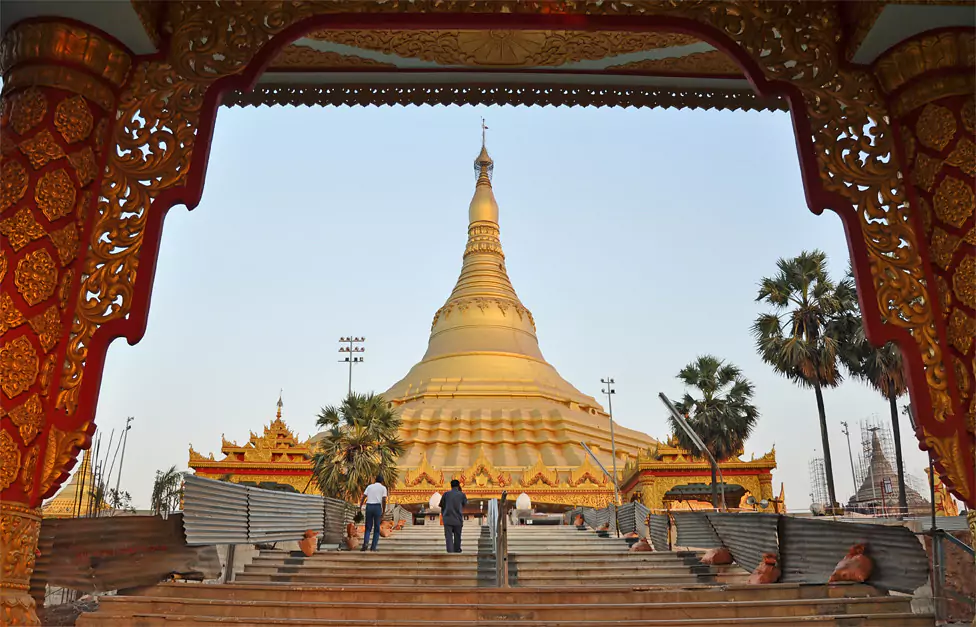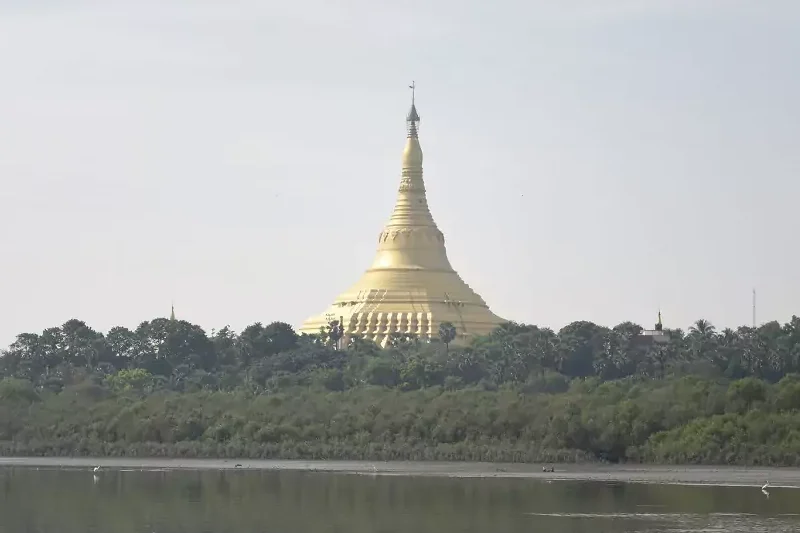The Global Vipassana Pagoda, Mumbai‘s tribute to the Buddha, has quickly established itself as one of the most significant architectural and cultural landmarks in the city. The world’s largest stone dome, which is less than ten years old and was constructed without any supporting pillars, is inside the breathtakingly magnificent pagoda.
The dome is twice as large as the Gol Gumbaz in Bijapur, whose dome once held the record for the largest hollow stone structure in the world.

What is Global Vipassana Pagoda?
The Globe Vipassana Pagoda is a meditation dome hall at Gorai, northwest of Mumbai, Maharashtra, India, with a capacity for 8,000 Vipassana meditators (the largest such meditation hall in the world). Pratibha Patil, the then-President of India, dedicated the pagoda on February 8, 2009.
On a peninsula between Gorai Creek and the Arabian Sea, it is situated on donated property. The pagoda is intended to stand as a symbol of harmony and serenity. The World Vipassana Pagoda was constructed in honour of Sayagyi U Ba Khin, a Vipassana instructor and the first Accountant-General of Independent Burma (1899–1971), who played a crucial role in bringing Vipassana back to India, where it originated.
History of Global Vipassana Pagoda
To raise awareness of Dhamma, the Buddha’s teachings, Shree S. N. Goenka, a well-known Vipassana meditation instructor, suggested the idea of the World Vipassana Pagoda in Mumbai. The goal was to better people’s ways of living and instil in them those fundamental principles.

He believed it was essential for bringing about world peace and harmony. Although the planning for this Global Pagoda Vipassana centre started in 1997, construction didn’t begin until 2000. Moreover, the tallest and first dome of the three was finished in 2006. From that time, the bones of Gautam Buddha have been stored here.
The two smaller domes’ construction was finished by 2008, and the Global Pagoda temple opened its doors to pilgrims and tourists in 2009.
Shree Goenka thought that the pagoda would be useful in educating people about the Vipassana meditation practice as well as the meanings of the Dhamma. Later, in 2012, he was given the Padma Bhushan award for his work.
Architecture of Global Vipassana Pagoda
The dome of the World Vipassana Pagoda is around 29 metres high. Eight thousand people can sit in the pagoda’s empty interior, which serves as a meditation hall where they can practise Vipassana meditation according to Shri S N Goenka’s teachings. The building is 96.12 metres tall overall.
The 13-acre World Vipassana Pagoda is being built, and it combines Buddhism and Burmese architectural styles. The pagoda’s shape and colour are identical to those of Myanmar’s Shwedagon Pagoda, which is also painted a similar gold colour. The Burmese provided actual gold to cover the spire. A sizable crystal is used to embellish the top.

Basalt serves as the Global Pagoda’s foundation. Each sandstone block used to construct the dome weighed roughly 600–700 kg, and interlocking bricks held them in place.
Together with the stunning architecture of the World Vipassana Pagoda, you’ll notice the patterns on the wooden entrance doors. In Myanmar, they were carved by hand.
Things to do at Global Vipassana Pagoda:
There are several activities you can partake in when visiting the Global Vipassana Pagoda to take in the beauty of the location.
- Appreciate the Building Design
Several architects and photographers have admired the Pagoda’s Burmese-style building. The dome’s attractive and practical structure with a golden covering is what draws many tourists to it, with Arabian waters serving as its backdrop.
- Discover the Teachings and Life of Lord Buddha
Pagoda, which is committed to enlightenment, the Dhamma, and the teachings of Lord Buddha, fulfils its mission by offering free courses on Buddha’s teachings on gratitude and the abolition of suffering. Inside the complex of monuments, there is a library and museum that provide the same function.
- Use Meditation to Spiritually Enlighten Yourself
A ten-day meditation course is provided for free at the complex’s Dhammaratana Meditation Center. Accommodations are available at the facility in identically constructed rooms. For individuals with a hectic schedule, there are also one-day courses available.
- Taking classes in Vipassana
The 10-day Vipassana meditation training is offered at Dhamma Pattana without charge. There are comfortable lodging options in the centre. For people who want to practise Vipassana for longer periods, advanced global Vipassana pagoda courses are offered.
Older students also have the option of enrolling in a one-day Global Pagoda course to stay current with the methodology. To practise meditation without interruptions, you can use the private cells in the South Pagoda, which is close to the Dhamma Pattana Vipassana centre.
- Exploring More Buildings in the Complex
Along with the Vipassana Centre and the meditation domes, the complex features a few more noteworthy locations. The Bell Tower contains a big bell and is ornamented in the traditional Burmese manner. The Gong Tower is another similar-looking structure; however, it is topped with a huge round gong. The Ashoka Pillar of Sarnath replica, which stands 52.4 feet tall, is a tiny waterfall, and a fountain with water gods will follow.
- Having Lunch at the Food Court
Visitors can get hygienic vegetarian meals and drinks at the campus’s small food court. Tea, coffee, and other beverages are available there as well.
Purchasing Trinkets from the Shop –
Visit the complex’s gift shop to purchase mementoes and learn more about the World Vipassana Pagoda. There are numerous books, CDs, and pictures available. For you to take home as keepsakes, the store also sells keychains, t-shirts, caps, and other trinkets.
Interesting Facts about Global Vipassana Pagoda

- Shree S. N. Goenka popularised the nonsectarian Vipassana meditation method, which is promoted by the World Vipassana Pagoda.
- On December 21, 2008, Shree Goenka participated in the first-ever one-day meditation workshop as a teacher.
- More than 160 centres in more than 60 countries offer instruction and practice in the method.
- On October 29, 2006, the bone remains of Gautam Buddha were housed inside the dome.
- The artefacts were first discovered in the southern Indian city of Guntur (Andhra Pradesh).
- The Global Vipassana Pagoda received the relics from the Mahabodhi Society of India and the Prime Minister of Sri Lanka.
Places to Visit near Global Vipassana Pagoda
- Essel World and Water Kingdom
- Gorai Beach
Timing and Entry Fees
Monday through Sunday, 9:00 am to 7:00 pm (Last entry at 6:30 pm)
There is no entrance fee needed to view the pagoda. Also, there is no fee to have a tour guide show you around.
Official Website: https://www.globalpagoda.org/ (For more detail, please visit official website of Global Vipassana Pagoda)
How to Reach Global Vipassana Pagoda?
Travelling via Road: If you want to reach Global Vipassana Pagoda by vehicle or cab, you can directly head towards Mira Bhayander Golden Nest Circle via Western Express Highway.
At the Golden Nest Circle, turn left to cross the flyover bridge, which will take you to Bhayander West. Keep going straight and take a right turn once you reach the end of the road.
Turn Left and keep going straight, following the directions for Esselworld or Global Vipassana Pagoda.
Travelling via Rail (Mumbai Local Train): If you are coming here by local train, you can get down at Borivali Railway Station. You can take BEST Bus no. 294 and 247 to reach Gorai Creek or take an autorickshaw.
Take a ferry ride to Esselworld from Gorai Jetty. Once you reach the other side of the creek, you need to walk following the sign to reach the Global Vipassana Pagoda, which is approx 1 km from Esselworld jetty.
Alternatively, you can also reach Global Vipassana Pagoda via Bhayander. Get down at Bhayander Railway station and hop to MBMT Bus no. 4 or take an autorickshaw. (MBMT Bus timings are 6.30 am to 6 .45 pm)
Conclusion
The Global Vipassana Pagoda is a magnificent structure located in Mumbai, India, that is dedicated to the practice and teachings of Vipassana meditation. The pagoda serves as a centre for practising and learning Vipassana meditation, which is a technique that helps individuals achieve mental clarity and inner peace.
Aside from its religious significance, the pagoda also serves as a centre for cultural and educational activities. It hosts various events and exhibitions that promote the teachings of Vipassana meditation and the values of peace, harmony, and tolerance.
Overall, the Global Vipassana Pagoda is a must-visit destination for those seeking inner peace and spiritual growth. Its serene environment and cultural significance make it a truly unique destination in the heart of Mumbai, India.
